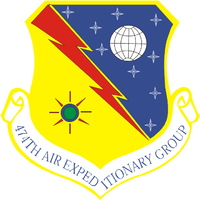474th Air Expeditionary Group
| 474th Air Expeditionary Group | |
|---|---|

474th Air Expeditionary Group emblem
|
|
| Country | United States |
| Branch | United States Air Force |
| Commanders | |
| Notable commanders |
Colonel John S. Loisel |
The 474th Air Expeditionary Group (474 AEG) is a provisional United States Air Force unit assigned to Air Combat Command. It may be activated or inactivated at any time.
Currently, the 474 AEG is stationed at Davis-Monthan AFB, Arizona, and is deployed to Guantanamo Bay Naval Base Cuba. Its current mission and operational components are undetermined, however it appears to be primarily a Civil Engineering organization.
Its World War II predecessor unit, the 474th Fighter Group, was a Ninth Air Force combat unit which fought in the European Theater. First deployed to England, it provided tactical air support in support of U.S. First Army until V-E Day.
The 474th Fighter Group was constituted on 26 May 1943 and activated on 1 August 1943 at Glendale, California. For the next several months the group trained for combat with P-38's. Moved to England, February–March 1944 where it was assigned to Ninth Air Force.
The grass airfield and sandy soil at RAF Warmwell was considered suitable to support the 80 aircraft of a fighter group without metal tracking support. The personnel of the 474th Fighter Group arrived on 12 March from Oxnard Flight Strip, California flying Lockheed P-38 "Lightnings".
The 474th was a group of Ninth Air Force's 70th Fighter Wing, IX Tactical Air Command.
Probably because they detrained at Moreton railway station, the group often referred to RAF Warmwell as Moreton. Squadron markings on the vertical tail surfaces were a square for the 428th, a triangle for the 429th and it circle for the 430th. The 474th FG was the only one of the three Ninth Air Force groups equipped with the P-38 in England that had trained with the type in the United States.
The 474th carried out its first mission on 25 April with a sweep along the French coast. The P-38's ability to carry two 1,000 lb bombs with ease, and its heavy nose-mounted armament, made it an excellent ground attack aircraft, although it appeared to be far more vulnerable to light anti-aircraft and small arms fire than the redoubtable P-47. During 15 weeks of operations from Warmwell, 27 P-38s were missing in action, all but five known or suspected lost due to ground fire. Three of these were lost to a 'bounce' by FW 190Ds while escorting B-26s on 7 May.
...
Wikipedia
